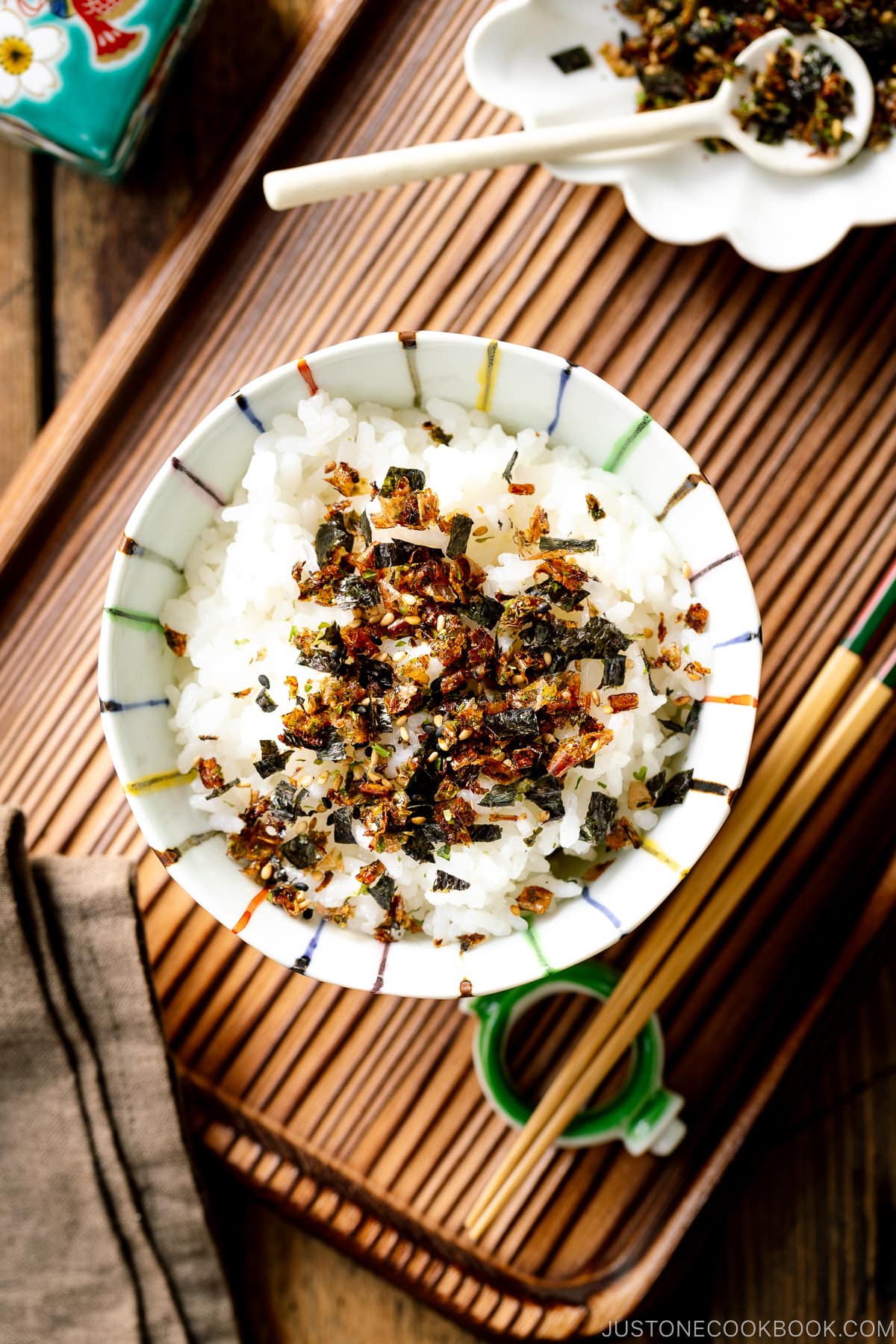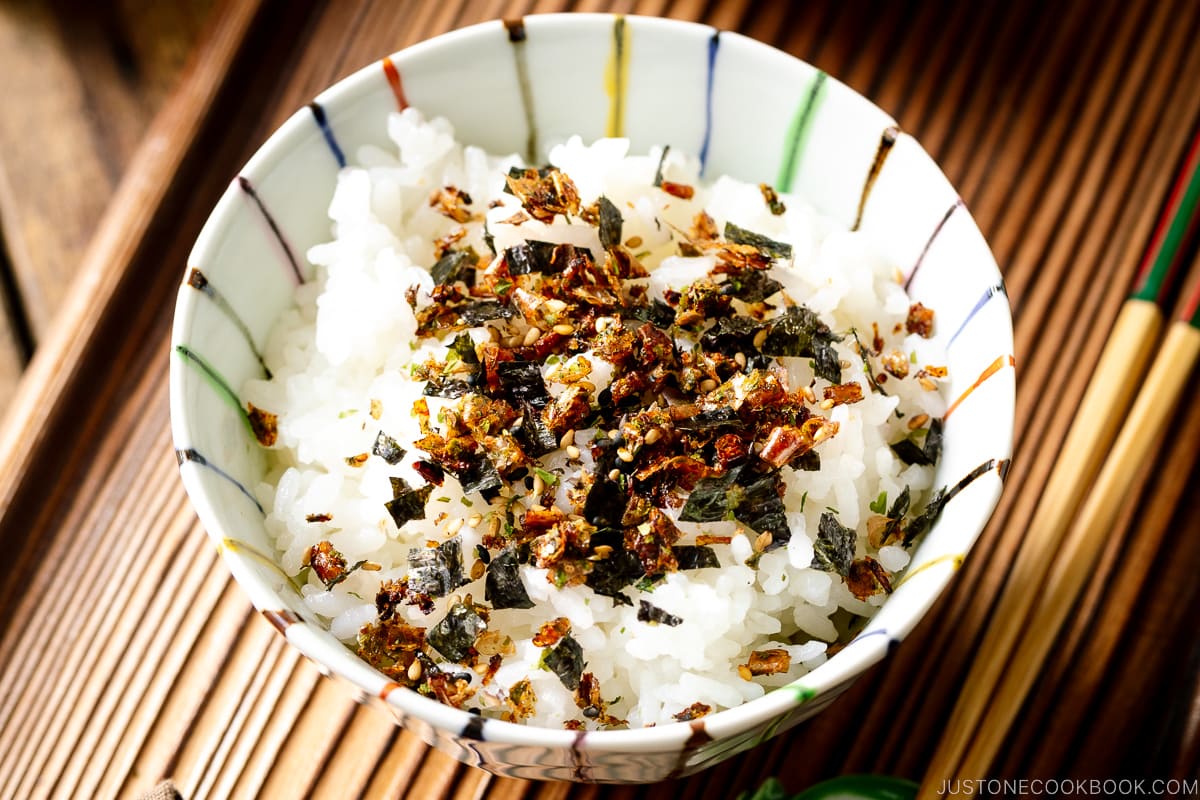Furikake (Japanese Rice Seasoning) ふりかけ • Just One Cookbook
Furikake is a savory and sweet rice seasoning made with sesame seeds, katsuobushi, green seaweed flakes, and nori seaweed. While this quintessential Japanese condiment is fabulous on steamed rice, it’s also delicious as a sprinkle on onigiri, udon noodles, soup, salad, popcorn, and more! Bonus: My homemade recipe is a great way to repurpose leftover bonito flakes and kombu from making dashi.

Furikake (ふりかけ) is a nutty, crunchy, umami-packed Japanese blend used to season rice. Although it’s referred to as a rice seasoning, furikake is literally the salt and pepper of the Japanese kitchen. It is so versatile that you can use the seasoning to instantly perk up any bland dishes.

What is Furikake?
Furikake (literally “sprinkle”) is a flaky or powered Japanese seasoning consisting of sesame seeds, seaweed, and dried seafood, meat, or vegetable. You may be familiar with the commercial variety in bottles or individual packets for kids and adults. Even Trader Joe’s has their own version of Nori Komi Furikake Seasoning!
The commercial variety contains a mixture of bonito flakes, toasted sesame seeds, nori seaweed, sugar, and salt. Some include salmon flakes, dried baby shrimp, shiso, egg, wasabi, and vegetables.

Furikake History
It goes back to the 12th century when there are records of making a salty powdered condiment consisting of dried sea bream, salmon, and shark. The current iteration was invented in the early 20th century as a nutritional supplement. It contained ground fish bones and poppy seeds to address the calcium and nutrient deficiency among the population.

How to Make Homemade Furikake
Ingredients You’ll Need
💡 Tip: If you have reserved kombu and katsuobushi from making dashi or mentsuyu noodle soup base, you can repurpose them in this recipe! Read the details below.
Overview: Cooking Steps
This homemade furikake is really easy to make!
- Cook all the ingredients and seasonings in a frying pan until they are dry and separated.
- Let cool completely.
- Add nori seaweed and transfer to an airtight container.

Repurposing Spent Katsuobushi and Kombu
Whenever you make dashi (Japanese soup stock) from scratch, you are always left with spent kombu or katsuobushi, or usually both if you make Awase Dashi (a combination of kombu and katsuo dashi).

The best way to repurpose these spent ingredients is to make homemade furikake.
Another bonus is that you don’t have to use them right away. You can reserve spent kombu and katsuobushi in an airtight container and store it in the refrigerator for a week or in the freezer for up to a month, until you’re ready to make furikake.

Take out the portion you need and cut them into small pieces and cook in the pan with the rest of ingredients.

FAQs
Why do we need to cook the ingredients? Can we just mix everything?
There are two reasons why we cook all the ingredients and season them in a frying pan.
- Dry ingredients absorb all the delicious wet seasonings (soy sauce and mirin), and then become dry. So the ingredients will be flavored.
- If you don’t cook the mixture, loose dry seasonings such as sugar and salt will sink at the bottom of the container and you will end up with a flavorless furikake.
How long does it last?
If you include a Food Safe Silica Gel Desiccant Packet in your airtight container, you can keep the homemade furikake for 1-2 months at room temperature!

Without it, the nori and katsuobushi will start to get stale, so consume the homemade furikake within 2 weeks.

Creative Ways to Enjoy Furikake
Rich in calcium, iodine, and iron, this homemade furikake is a healthy way to season your Japanese dishes!
Furikake is absolutely wonderful on just a simple bowl of rice, porridge, or udon noodles. It’s also perfect for seasoning onigiri (Japanese rice balls), soba noodle salad, grilled salmon, or rice crackers. But don’t stop there, furikake is so versatile that I love to get creative and sprinkle it on these as well:
- Avocado – this is my favorite. Keep it simple and halve the avocado and season it with furikake as an afternoon snack. For a savory breakfast, smear your toasted bread with mashed avocado before you give it a good sprinkle of furikake. It’s a Japanese-twist on avocado toast.
- Egg – you can totally replace salt and pepper with furikake on a fried egg or soft-boiled egg when you want something more punchy.
- Popcorn – planning on binge-watching Japanese shows on Netflix or a Japanese movie night? Flavor your homemade popcorn with furikake to keep to the theme.
- Pasta – oh yes, you can top furikake on Mentaiko Pasta, cacio e pepe pasta, or any simple creamy pasta.
- Furikake Chex Mix – This is one of our family’s holiday edible treats!

A Great Holiday Gift
If you make a big batch, you can even freeze the seasoning for a month. Furikake makes a great holiday gift. Just pack the Japanese seasoning in a cute little glass jar to surprise your foodie friends and family!

Make sure to add a Food Safe Silica Gel Desiccant Packet for each jar, so your friends and family can enjoy it for 1-2 months!

Wish to learn more about Japanese cooking? Sign up for our free newsletter to receive cooking tips & recipe updates! And stay in touch with me on Facebook, Pinterest, YouTube, and Instagram.

Furikake (Japanese Rice Seasoning)
Furikake is a savory and sweet rice seasoning made with sesame seeds, katsuobushi, green seaweed flakes, and nori seaweed. While this quintessential Japanese condiment is fabulous on steamed rice, it’s also delicious as a sprinkle on onigiri, udon noodles, soup, salad, popcorn, and more! Bonus: My homemade recipe is a great way to repurpose leftover bonito flakes and kombu from making dashi.
Ingredients
Add-On Ingredients (after cooling)
Instructions
To Prepare the Spent Katsuobushi and Kombu (if using)
-
Make sure the spent katsuobushi is well drained. Cut it into small pieces with a knife.
-
Slice the spent kombu (optional) into thin strips, and then cut the strips into small pieces.
To Cook the Furikake
-
In an ungreased frying pan, add the katsuobushi (or spent katsuobushi), aonori, and spent kombu (optional). Don’t add the sesame seeds yet! Then, add all the seasonings and mix it all together.
-
Turn on the stove’s heat to medium low and cook, stirring constantly, until the katsuobushi becomes dry and flaky.
-
Now, lower the heat and add the white and black sesame seeds. Cook, stirring frequently, on low heat until the sesame seeds are nicely roasted and fragrant.
-
Transfer the furikake to a baking sheet lined with parchment paper. Spread it out and let it cool completely.
-
Once it’s cooled, cut the nori sheet into thin strips, and then small pieces ⅛ inch (3 mm) square.
-
Add the nori pieces to the cooled furikake and mix everything together.
-
Taste the furikake and adjust the seasonings by adding more salt or sugar at this step. I decided to add additional aonori for enhanced color and taste (optional).
-
In an airtight glass jar, add one Food Safe Silica Gel Desiccant Packet on the bottom, add the furikake, and close the lid tightly.
Nutrition
Serving: 1 cup · Calories: 270 kcal · Carbohydrates: 13 g · Protein: 14 g · Fat: 18 g · Saturated Fat: 3 g · Polyunsaturated Fat: 8 g · Monounsaturated Fat: 7 g · Sodium: 922 mg · Potassium: 190 mg · Fiber: 4 g · Sugar: 6 g · Vitamin A: 584 IU · Vitamin C: 4 mg · Calcium: 320 mg · Iron: 5 mg
Editor’s Note: This post was originally published in July 2013. It has been republished on November 27, 2022, with the revised recipe, new images, and updated content with more information.







